Fried pork belly is a traditional Hakka recipe that marinates the meat with fermented beancurd 腐乳 and Chinese five-spice 五香粉 powder. It is hugely popular due to its simplicity and unique savory taste.
There are only two steps to preparing Hakka deep-fried pork. First, marinate the pork with a mixture of fermented beancurd, five-spice powder, and other seasonings, then deep-fry it until crispy.
Note: This post may contain affiliate links. Please read my privacy policy for more info. I may receive commissions for purchases made through links in this post. As an Amazon Associate, I earn from qualifying purchases.

🛒Ingredients needed for Hakka Fried Pork Belly
- Pork. The most common cut of pork for deep-frying is pork belly, which gives the best result. Pork belly has a relatively higher fat, which will remain juicy after deep-frying with high heat. The pork fat will render during the process, changing the texture of the fat from soft and spongy to a slightly firm texture with a crispy surface. These changes will prevent it from feeling oily when you bite on it. Of course, you can use collar butt or pork loin if you prefer less fatty, but the texture will be drier than pork belly.
- Marinade. The marinade consists of some common ingredients plus two unique ingredients: fermented beancurd and Chinese five-spice powder. Combining the fermented beancurd and the spices produces the unique yet memorable flavor of the Hakka fried pork belly. There are two types of fermented beancurd, the red 南乳 and the yellow-light brown 腐乳. There are some differences between the two besides the color. Red fermented beancurd has a tinge of sweetness and saltiness, while the yellow type is more savory. I use an equal portion of both in this recipe, but you can use either one if you prefer. If you use the red type entirely, you will expect the color of the fried pork to become darker after deep-frying.
- Five-spice Powder. Chinese five-spice powder consists of star anise, fennel, peppercorns, cinnamon, and cloves. It is quite a standard mix of spices for Chinese cooking and is readily available at most large grocery stores.
- Others. Other ingredients are oyster sauce, ground white pepper, garlic, ginger, sugar, and Shaoxing wine (Chinese cooking wine). These are the standard items in most Chinese kitchen pantries. I suggest mincing the garlic and ginger finely before adding them to the marinade to ensure they will stick well to the meat. Alternatively, add a tablespoon of water to the chopped ginger and garlic, then squeeze out the juice. Then, discard the ginger and garlic and use the juice only to marinate the meat.
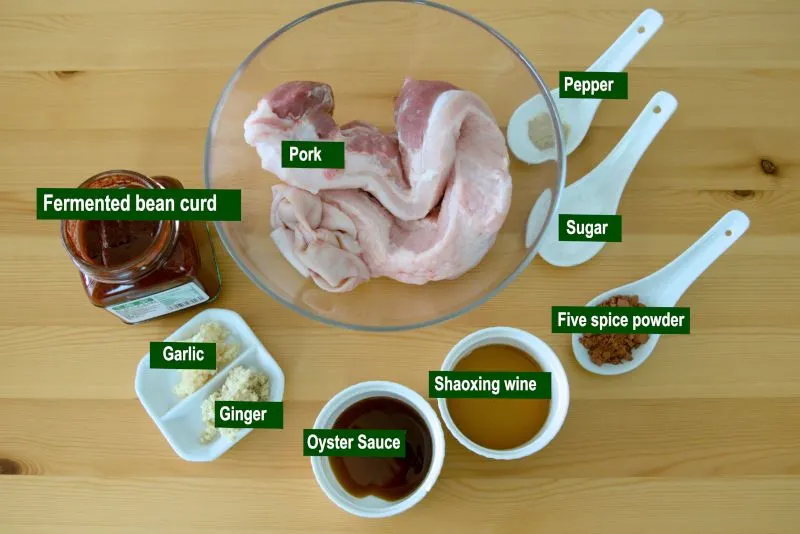
👉 How to cook Hakka Fried Pork Belly?
1. Remove the pork skin. Pork belly is usually sold with the skin on. To remove the skin, place the pork belly on a cutting board. Use a sharp knife to make a small cut in the skin, starting from one side of the pork. Hold the free part of the skin with one hand and pull it away from the meat to create tension. Then, carefully slide the knife parallel to the skin with some force applied in the opposite direction of your other hand, and glide to remove it from the meat. For a more detailed explanation, please refer to the video in this article.
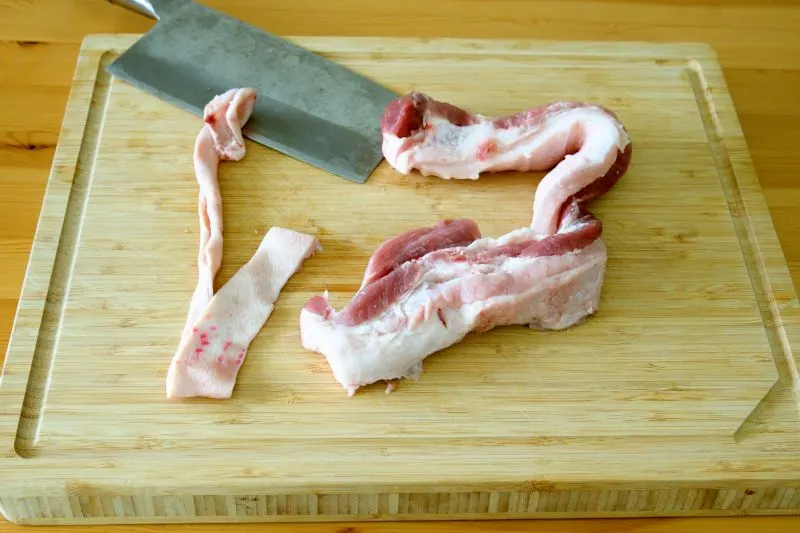
2. Cut the pork into your preferred size. (Please refer to the Tips section below for more details.) Once you have cut the meat, transfer it into a large mixing bowl.
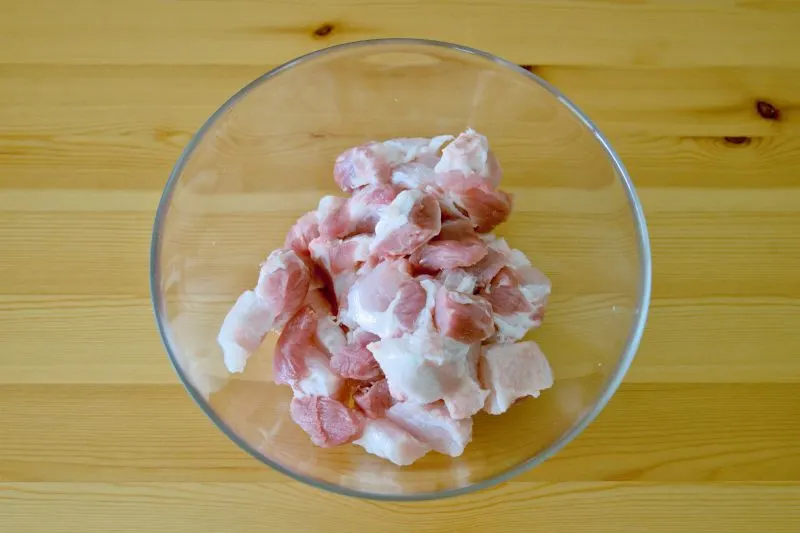
3. Mash the fermented beancurd with a fork, dilute it with wine and oyster sauce and combine it with the remainder of the marinade ingredients to form a thick paste.
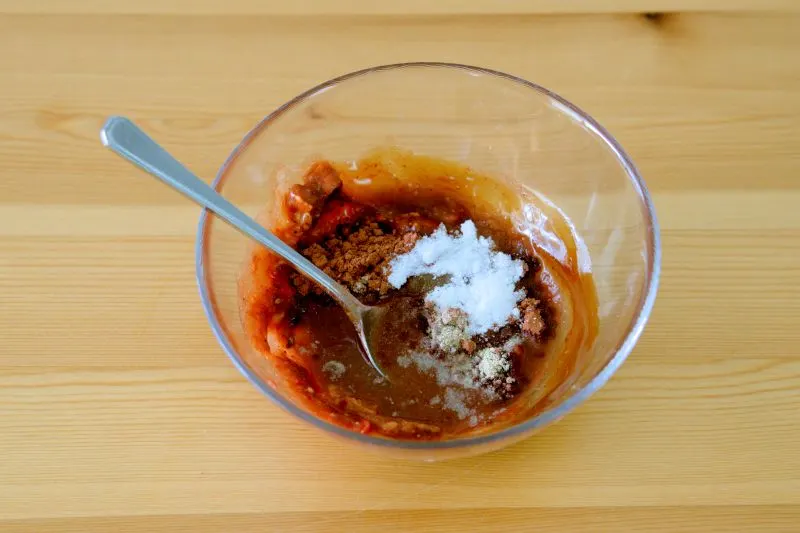
4. Massage the marinade into the meat. Marinate for half a day, or preferably overnight.
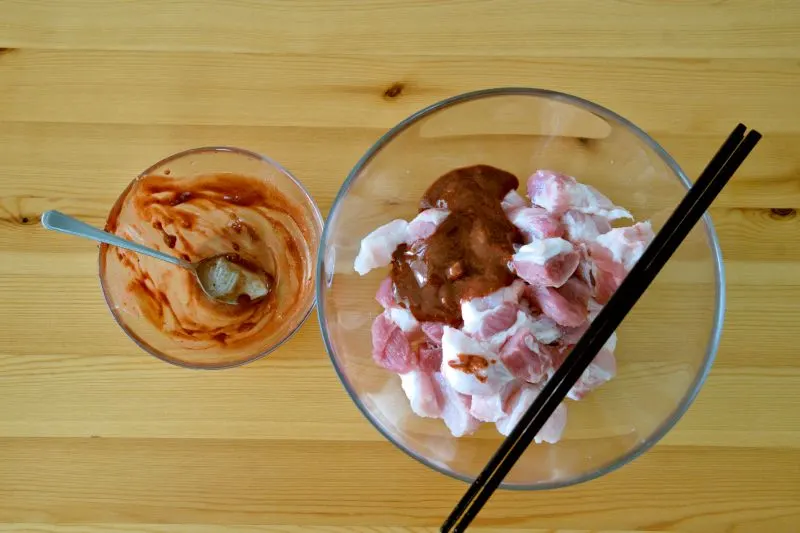
5. Before deep-frying the pork, coat the pork with cornstarch. I would suggest using a pair of chopsticks to roll the meat pieces in cornstarch. The marinade and the moisture from the pork will bind with the cornstarch, making it pretty sticky and messy if you use your hands to mix it. After coating with the starch, shake off the excess. Let it rest for five minutes before deep-frying.
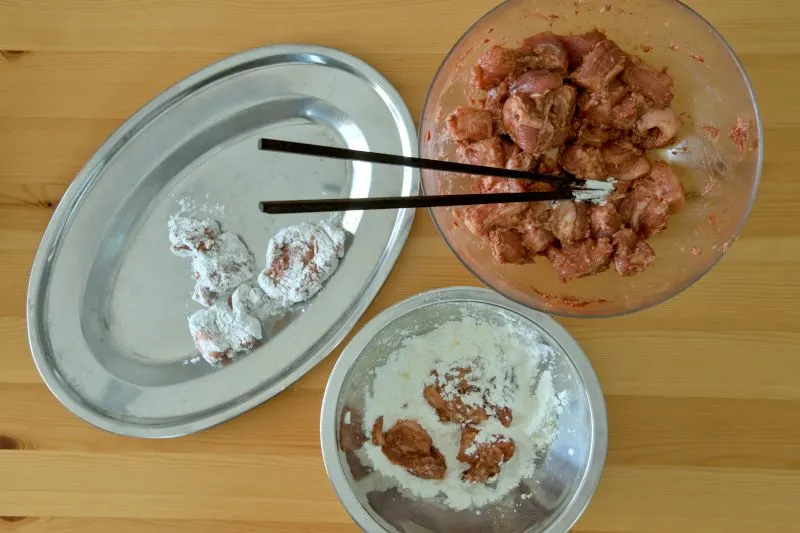
6. To deep-fry the first round, Heat the oil to about 150°C/300°F. Place the pork belly slices into the oil to deep-fry for three minutes over medium-high heat, then flip over and continue for another three minutes. The endpoint is when they have become light golden.
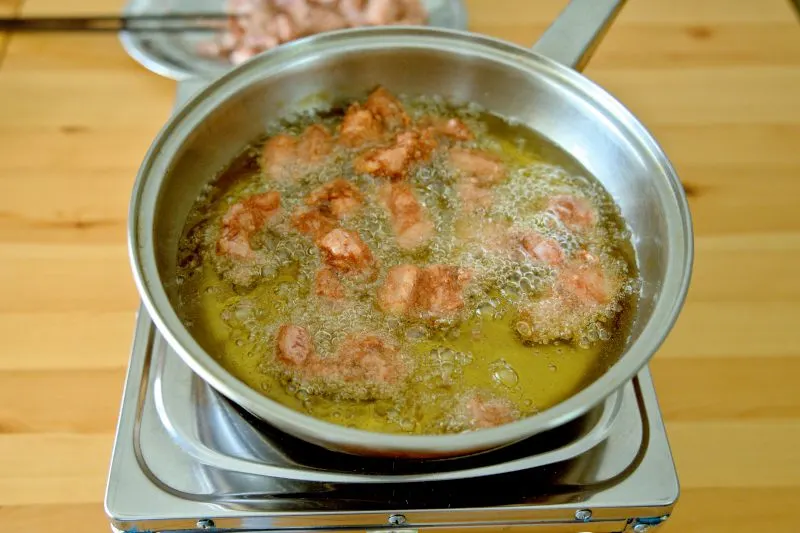
7. Let the pork cool for ten minutes before deep-frying for the second round. This time, the temperature should be at around 200°C/390°F. This time, if you put the chopsticks into the oil, streams of bubbles will rise vigorously around it instead of bubbling slowly. The second round of deep-frying takes about one minute, and you should keep watching closely as the color will turn quickly at a high temperature.

8. Once the color turns golden brown without burnt pieces, remove the pork belly pieces immediately and drain them on a paper towel or a wire rack.
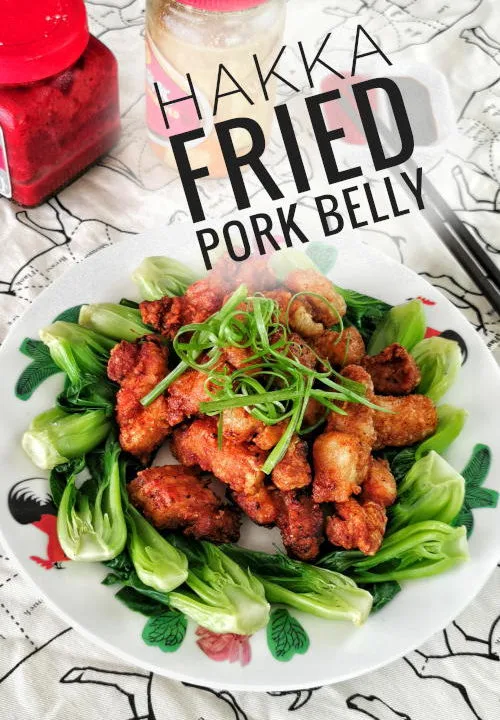
💡Tips and notes for the best fried pork belly
- Once you have removed the skin, you can cut the pork into small pieces or a larger slab. If you cut it into small pieces, as in this pork belly recipe, the pork will become crispier after deep-frying as the surface coated with cornstarch is larger. However, if you prefer cutting it into a larger slab, you can slice the large chunk into pieces to reveal the internal of the meat while serving.
- Traditionally, a combination of tapioca starch and rice flour is used to coat the pork before deep-frying. However, I have also tried using cornstarch alone, which yields a crispy exterior up to half an hour after deep-frying. Therefore, you can use either one, depending on what is available.
- Remove the marinated pork from the refrigerator on the following day. I would let the pork return to room temperature before deep-frying it. Otherwise, the inner part of the pork may not cook fully when the outside has already turned golden.
- After thoroughly coating each piece of meat with cornstarch, let it rest for five minutes before deep-frying for the first round. The short rest allows the moisture from the meat and the marinade to absorb the cornstarch, making it firmly adhere to the meat. Otherwise, the cornstarch tends to drop off and dirty the oil if you deep-fried the meat immediately after coating the pork.
- A kitchen thermometer is common nowadays, so you can get one to check the oil temperature. Otherwise, you can test the temperature by dipping wooden chopsticks into the oil. You need to deep-fried it twice to get the perfect crispy pork belly. The temperature is correct for the first round of deep-frying if there are streams of bubbles rising around the chopsticks slowly. The second round should be much hotter, that is, when the bubbles are rising vigorously. We use an electric deep fryer in the restaurant, which can adjust the temperature.
- The end of the cooking time depends on the pork size and the oil temperature. Therefore, the actual time required may vary from this recipe. The best way to decide when to remove it from the oil is to look at the color.
- To serve the Hakka deep-fried pork belly, it is best to serve it with some vegetables since it is fatty. You can serve it with lettuce or any salad of your choice. My more traditional approach is to blanch some leafy vegetables, such as bok choy, which doubles up as a garnish.
- This recipe is quite similar to lechon kawali, a Filipino deep-fried pork recipe.

♨️ Can I air fry the pork instead of deep frying it?
Good Hakka-style fried pork needs to be very crispy, so I don’t recommend air-frying for this recipe. Air fryers are extremely popular nowadays, and I use them often at home. However, an air fryer won’t be able to produce the extra crispy pork in this recipe. That’s why we use the double-fry method to achieve extra crispiness.
🍽️ What is the best way to serve Hakka Deep-fried Pork?
Since the pork is deep-fried, serving it with some green vegetables is best. You can also serve it with any salad you like, but my favorite way is to serve it with some stir-fried bok choy.
🆒 How to store and reheat the leftover Hakka Fried Pork Belly?
The most attractive feature of this deep-fried pork recipe is its crispiness. Therefore, I do not suggest keeping any leftovers over a few days. If you have any leftovers, please keep them in an airtight container in the refrigerator. You should consume the leftovers within the next few days, not longer than that. To serve, let the pork return to room temperature, and then deep-fry it in oil for half a minute to recreate the crispiness before serving.
📜 Here are some other pork recipes you might be interested in trying.
Here are two related pork recipes specially picked for you if you enjoy this fried pork belly.
- Braised pork belly is a well-known dish prepared with ginger, garlic, soy sauce, and myriad aromatic spices. It is cooked over an extended period until the fat is gelatinized and the meat attains a melt-in-the-mouth texture.
- Bak Kut Teh is a popular meat dish in Malaysia and Singapore. It is a meat and pork rib dish cooked in a broth with various Chinese medicinal herbs. This recipe explains how to prepare Bak Kut Teh at home.

Fried pork belly Hakka style - Quick and easy recipe
Fried pork belly is a traditional Hakka recipe that uses fermented beancurd and Chinese five-spice powder as the main ingredients to marinate the meat.
It has become a popular dish among the Chinese family due to its simplicity and unique savory taste.
Ingredients
Ingredients A (Marinate the pork)
- 400g pork belly (weight include skin)
- 2 fermented beancurd (refer to note below)
- 2 tsp minced ginger
- 2 tsp minced garlic
- 1 tbsp Shaoxing sine
- 2 tsp oyster sauce
- 1 tsp Chinese five-spice powder
- 1 tsp sugar
- 1/4 tsp ground white pepper
Ingredients B (Others)
- Cornflour to coat the pork
- Vegetable oil to deep-fry
Instructions
Marinade the pork
- Remove the skin of the pork belly.
- Cut the pork into small pieces, about one inch length.
- Transfer it into a large mixing bowl.
- Mix the pork with all the ingredients in A.
- Store in the refrigerator to marinate overnight.
Deep-fry the pork
- Remove the marinated pork from the refrigerator.
- Roll the meat pieces in a bed of cornstarch.
- After coating each piece of meat thoroughly with cornstarch, let it rest for five minutes.
- Deep-fry the pork in oil at 150°C/300°F for three minutes, then flip over and continue for another three minutes, or until it is lightly golden.
- Let the pork cools for ten minutes.
- Deep-fry for the second round at 200°C/390°F for one minute.
- Remove the pork and drain them on a paper towel or a colander. Serve immediately.
Notes
The weight of each piece of the fermented beancurd I use is about 12g. I use one red and one yellow fermented beancurd in the recipe. Please adjust the number of fermented beancurd you use if what you have is of a different size.
Recommended Products
As an Amazon Associate and member of other affiliate programs, I earn from qualifying purchases.
Nutrition Information:
Yield: 2 Serving Size: 1Amount Per Serving: Calories: 949Total Fat: 65gSaturated Fat: 20gTrans Fat: 1gUnsaturated Fat: 42gCholesterol: 205mgSodium: 501mgCarbohydrates: 29gFiber: 3gSugar: 2gProtein: 60g
This data was provided and calculated by Nutritionix on 8/2/2021




How to make air fryer Char Siu (Chinese BBQ Pork) at home
Sunday 6th of July 2025
[…] red coloring widely used in Chinese cooking, not only for barbecue pork, but also for dishes like Hakka fried pork and the vegetarian dish Buddha’s […]
Lettuce with Fermented Tofu (Beancurd) | 5 Ingredients Simple Chinese Stir-fry
Wednesday 11th of December 2024
[…] for this dish. However, we have several other recipes on our blog that use it, including the Fried Pork Belly. It is a specialty in Chinese cooking, so it is most likely available at Asian […]
Mick
Tuesday 19th of October 2021
great simple dish
Mick
Tuesday 3rd of August 2021
Have not tried yet but will as soon as i chase up some fermented bean curd.Thanks Mick
Jinyee Loi
Tuesday 3rd of August 2021
Hi, you mention about fermented beancurd but I couldn't find it in ingredient section. How much fermented beancurd is needed in this recipe? Thank you
KP Kwan
Tuesday 3rd of August 2021
Thank you for pointing the error in the recipe. I use two pieces of fermented beancurd. I have corrected it in the recipe.